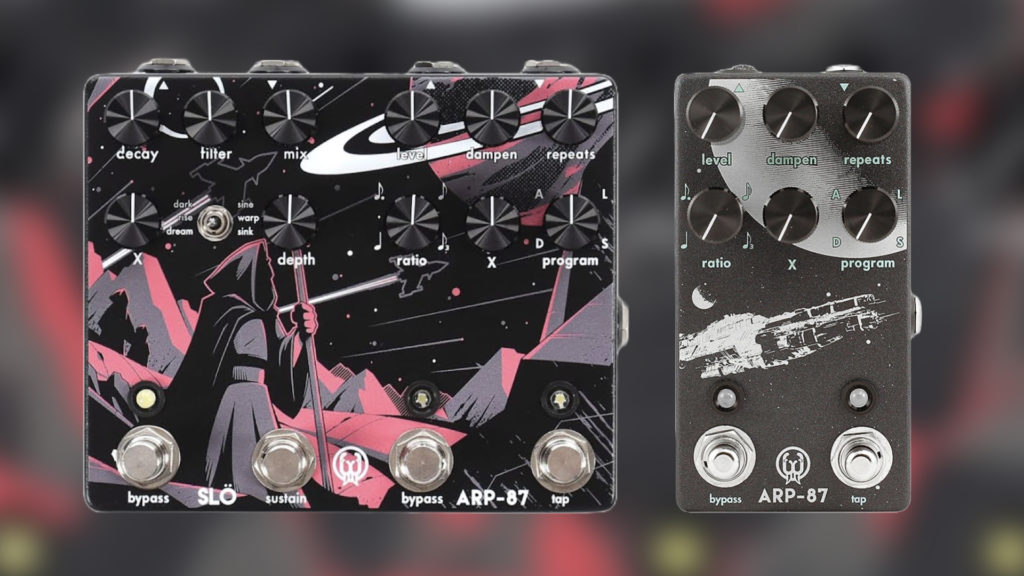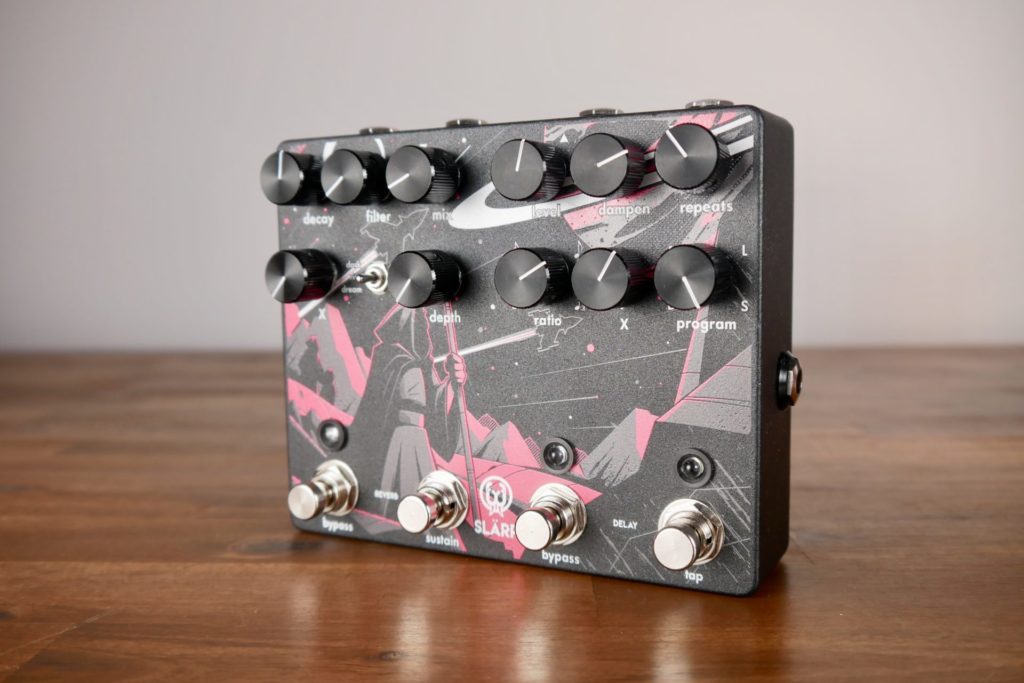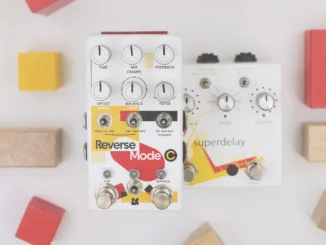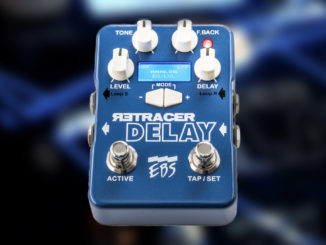This review looks closer at the Walrus Audio ARP-87 in the SLÄRP pedal, a multi-function delay with four types in combination with synths.
A little over a week ago, I checked out the Walrus Audio SLÖ in the SLÄRP special edition pedal for you. It’s a rich multi-texture reverb particularly suited to ambient music. Did I forget something? Yes, I have! The SLÄRP not only has a built-in reverb. It also has a versatile delay.
More precisely, the ARP-87, a multi-voice delay with a very clear, straight-to-the-point layout. I also tested it more closely, and in the following paragraphs, you will find out my verdict on the pedal, including a sound demo. And no, the ARP name has no relation to the synthesizer brand ARP. It would be nice.
Walrus Audio ARP-87 Review
Disclaimer: Thanks to the Viennese music shop Klangfarbe.com for kindly lending me the SLÄRP (SLÖ + ARP-87) for two weeks for testing.
The ARP-87 is a compact multi-algorithm delay pedal with a dense feature set. As with the SLÖ review, the ARP-87 core is in the SLÄRP special edition pedal, which can be used independently or with the reverb. Visually, no matter whether the ARP-87 or SLÄRP are real eye-catchers. Both have beautiful designs that stand out.
ARP-87 is a mono pedal with a mono input/mono output, and a tap input on the side. There is no MIDI, so you can manually adjust the delay time via tap tempo—less of a problem for guitarists but favorable for Synthesizer players who like to have everything in sync.
The same applies to the mono configuration of the pedal, which limits one to mono output synths. Or you buy two ARP-87 pedals for stereo operation. Walrus Audio is focusing on the guitarists here, not synths. Don’t worry, the pedal harmonizes very well with synth signals.
Hands-on Interface
One of the points that distinguish it is its hands-on, straightforward design. No menus; you have everything right at your fingertips. This allows quick tweakings of the pedal without getting lost in a menu forest.
Arp-87 has six different parameters/knobs:
- level sets the level of the repeats – the amount of the effected signal, aka dry/wet mix control
- dampen is a lowpass filter that shapes the tone of the delay effect (left darker tones, right more clarity)
- repeats adjusts the number of repeats (from one to almost infinite)
- ratio subdivision for the tap tempo (in the slap algorithm, it adjusts the delay time). (quarter, dotted 8, 8 notes, and triplets)
- program sets the algorithm (D – A – L – S)
- X, the special parameter for each algorithm
I find the decision not to have a dedicated knob to set the repeat rate by ear strange. This would allow you to adjust it more quickly and accurately. Thus I recommend you to try out the pedal to ensure you can live without this ability.
Also a bit unusual is the default time setting for each algorithm. If you change the voice, the time setting is not adopted but must be reset each time. Yes, a bit odd for a digital pedal, resulting in fast algorithm changes are only possible to a limited extent. Particularly disadvantageous when jamming or performing.
There are also momentary functions for bypass and max repeats, allowing you to adapt the effect behavior to your workflows or even for live performances.
Two Operation Modes and 4 Delays In A Pedal
Walrus Audio gave the ARP-87 two operation modes: either trails or no trails mode. In simple words: you decide whether the delay trails fade away naturally or stop abruptly when switching off the pedal. For my demo, I chose trails mode.
The ARP-87 pedal consists of four delay algorithms, each selectable with a simple knob twist. So no rocket science. Each algorithm has a distinct character and a special parameter available via the X knob.
- digital delay (D) + modulation depth
- analog-style delay (A) + modulation depth
- lo-fi delay (L) + filter width
- slapback delay (S) + modulation depth
4 Delay Colors In Detail
The digital delay algorithm harmonies well with synthesizers. It produces nicely clear, soft timbres for classic subtle results up to rhythmic elements. Working with the modulation, you can infuse in the effect a more organic character and let it dive in the direction of a tape delay. Not 100%, but it goes in that lovely direction. I like the delay in a 50/50 ratio with medium repeats and light modulation.
Then, you have the analog-style delay. The analog counterpart has warmth, width, and lots of character. Precisely those are also the points of this digital implementation. The algorithm matches very well with synths. It envelops the sound nicely with a warm coat, including slightly overdriven patterns. And it makes it easy to nestle the sounds into a mix. It was a lot of fun working with it.
Lo-Fi is the third algorithm of the ARP-87 pedal and makes exactly what it says. It adds nice “noisy” artifacts to your delayed sounds that take you back to the vintage era. A time when delays weren’t crystal clear and pristine. It’s my algorithm highlight as it has the most personality.
This is particularly noticeable when playing with the dampen and X knobs, which introduce filtering. From beautiful warm, saturated delays up to weird, slightly glitch timbres, its sonic range is excellent. The filtering function is also handy for adapting the delay sound better to the reverb. Otherwise, it can become an overwhelming wash.
Fourth and final algorithm is Slap, an algorithm made for classic slapback echoes. This job master it. I think it goes better with guitars and basses. With high parameter values, however, I achieved some weird, beautiful experimental tones. So deeply resonating that the effect has turned into a shaping processor instead of a delay.
Regarding the sound palette, the ARP-87 is more at home in the subtle, classic range. No matter which algorithm is set. The pedal does not take the user to extremes, even with high repeats and maximum levels. You always stay more in a bread-and-butter, traditional domain. But always in prime quality.
Video Demo
A synth-focused demo with sounds sounds sounds can be found in my video review of the Walrus Audio ARP-87 in the SLÄRP pedal. Yes, exactly the video with the smiling gentleman that is linked here below. I hope you enjoy it.
Summary
The market for multi-voice delays is highly competitive. Even 5+ years after its introduction, it can still convince with a high-quality sound, premium-like finish, and a solid price-feature ratio. I particularly like that you have several different flavored algorithms that provide variety and flexibility.
In addition, the interface is very hands-on without menu diving, making it a pleasing user experience. The Arp-87 is particularly exciting for anyone looking for analog-colored sounds but does not want to miss the accuracy and flexibility of digital.
Yes, the pedal loves subtle tones; with the Lo-fi algorithm, for example, you can go beyond that. So it’s more possible than the usual tones, but don’t expect any experimental, extreme timbres; it’s more a classic.
Only mono signal processing and no MIDI casts a shadow over the pedal, especially from a Synthesizer player’s point of view. These algorithms in stereo would be remarkable no question. MIDI would be an excellent addition to a possible version 2. Nevertheless, the Walrus Audio ARP-87 was very convincing in the review. Highly recommend it if you are looking for classic delays with a twist while living with the weaknesses of the pedal.
Pro
- delay sound quality
- versatility and flexibility
- hands-on interface without menu diving
- built quality
- price/feature ratio
Neutral
- mono – mono signal path
- no MIDI
Contra
- a dedicated repeat rate knob is missing
Walrus Audio ARP-87 is available now for $199/219€.
More information here: Walrus Audio
Available at my partners: Thomann, Perfect Circuit, and Sweetwater








Be the first to comment